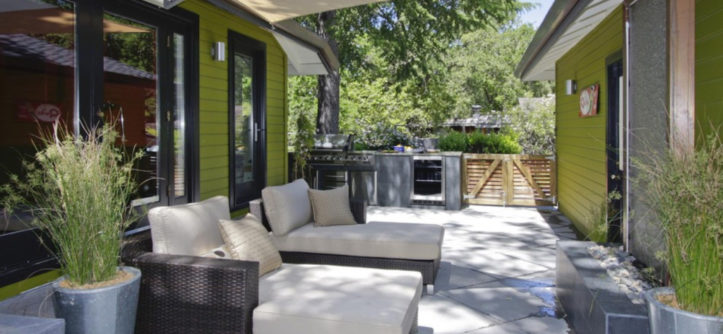One of the best ways you can improve and facilitate indoor/outdoor flow for your house is to add an awning. Here are five things to consider to ensure that you get an awning that works well, looks great and will stand the test of time without fading and tearing.
Here are five things to consider to ensure that you get an awning that works well, looks great, and will stand the test of time without fading and tearing.
1. How do you want it mounted?
When you’re thinking about awnings, the first thing you want to think about is how you want it mounted onto your house or business.
There are two main ways of doing this: mechanically, or chemically.
Mechanical mounting is mounting it to the wall with screws. While it’s sturdy and secure, it can cause damage in the long run, and may not be appropriate for some exterior materials.
Alternatively, you can go for chemically mounted, using extremely potent glue to hold it in place. While this is as secure, it may not last as long and can cause problems if you ever want the awning removed.
2. Awning material
There are three common options.
- Cotton. This is thin and has a distinctive fabric look, but can wear quicker than other, synthetic materials, even with a painted on the protective coating.
- Vinyl. Vinyl might not look quite as breezy and flowy as cotton, but it is more robust, particularly in wet climates. If you’re looking for an awning for rain and shine, then vinyl is a good option.
- Polyester. This is the middle ground between cotton and vinyl. More flexible than vinyl but less expensive and longer lasting than cotton, it’s the awning of choice for many customers.
3. Do you need an awning casing?
The next element you want to consider if whether or not you need an awning case. This is the case that will store your awning when it’s rolled up against your home or business.
While they’re not required, they will extend the life of your awning considerably by protecting it from foul weather.
This is the case that will store your awning when it’s rolled up against your home or business. While they’re not required, they will extend the life of your awning considerably by protecting it from foul weather.
4. Stationary or retractable?
A retractable awning, while more convenient since you can pull it in when you’re not using it, does limit the look you can achieve as well as adding cost. However, stationary awnings will often break faster due to their 24/7 exposure to the elements.
5. Awning retraction style
Finally, if you do opt for a retractable awning, what style of retraction do you want? First, there’s manual. It has the benefit of being inexpensive, but it does mean that you have to do it by hand, and if you’re out and the weather turns, you’ll have to rush home to get it in.
First, there’s manual. It has the benefit of being inexpensive, but it does mean that you have to do it by hand, and if you’re out and the weather turns, you’ll have to rush home to get it in.
Second, is the motorized retractable awning. These use a small motor to retract your awning. They’re fast and simple, which means anyone can use the, and they work quickly and well.
What’s more, you can also get automated ones, to extend when it’s sunny and pull back when the sun starts to pack in a little or can be set on a timer for peace of mind.
Wrap up
Those are our five top tips for what to look for when you’re looking into awnings. Now go get your next awning, so you can get on with the serious business of seriously enjoying your summer.
Still got questions? We’d love to hear them.
